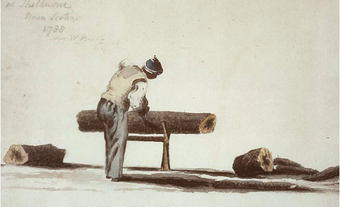Diorama
Diorama, museum exhibit which creates the illusion of a natural or historic scene. Typically, mounted animals and preserved plants blend imperceptibly into a realistic background painting, simulating a natural habitat (the name habitat group is sometimes used). Miniature dioramas recreate natural or historic scenes on a reduced scale. Dioramas are expensive to produce, but effectively convey atmosphere as well as information and are rightly popular with museum visitors. Large dioramas are produced by artists, taxidermists and modellers, using traditional materials and new plastics. Some new dioramas are being created using computerized enlargements of smaller paintings.
American taxidermist Carl Akeley created the first modern diorama in 1889. His first Canadian imitator, Lester Lynne Snyder, created dioramas at the ROYAL ONTARIO MUSEUM from 1919. Today, dioramas in major museums showcase the work of fine nature artists. The Nova Scotia Museum shows groups by Azor Vienneau. Ontario features Terry SHORTT'S world landscapes at the ROM, and representative scenes by Hugh Monahan, Clarence Tillenius and others at the NATIONAL MUSEUMS OF CANADA. At the Manitoba Museum of Man and Nature, Tillenius's spectacular Red River Hunt is complemented by several large ecological dioramas. The Saskatchewan Museum of Natural History devotes a floor to dioramas, mainly by Fred Lahrman and Robert Symons. The Provincial Museum of Alberta features a large gallery of groups (some of unusual depth), largely by Ralph Carson and Ludo Bogaert. The BC Provincial Museum presents, among others, a spectacular walk-through diorama of coastal forest and beach.

 Share on Facebook
Share on Facebook Share on X
Share on X Share by Email
Share by Email Share on Google Classroom
Share on Google Classroom


